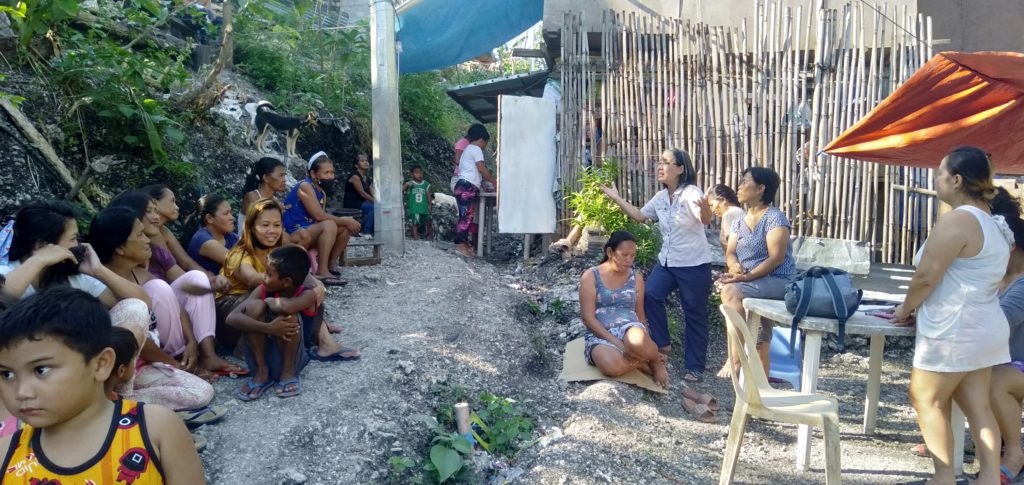Trained community health workers (CHWs) of three urban poor communities with ongoing community-based health programs have started to render health services using the primary health care approach.
This is in line with the project of the Visayas Primary Healthcare Services, “Building community-based health programs to promote health and prevent disease in urban poor communities in Cebu” in PurokTambis, Barangay Umapad, Mandaue City, SitioSawsawan, Barangay San Roque, Talisay City, and SitioIntramuros, Barangay Poblacion, Cordova. The project is supported by the Committee of German Doctors for Developing Countries, Inc. (CGD) and startedon May 2016.
The rolling clinics of the German Doctors in SitioCamolinas, Poblacion, Cordova and Sawsawan every Wednesday and Monday, respectively, and the rolling clinic in Umapad every other Thursday were opportunities for the trained CHWs to apply the knowledge and skills they learned in the basic health skills training conducted by VPHCS last July and August. The CHWs searched for the patients’ records, took the weights, blood pressure, pulse rate, temperature and ushered them to the German doctors.
In between rolling clinics, the CHWs did home visitations and conducted simple health teachings applying what they learned in the training. During the home visitations, when there were children who had simple cough and colds, the CHWs taught the mothers to give the children more fluids and extra nutrition, herbal plants such as lagundi, tamarind and calamansi.
Mothers of children with diarrhea were advised by the CHWs to use homemade oral rehydration salt solution using tablespoon of sugar and a pinch of salt in a liter of clean water or the fresh juice of coconut fruits to prevent dehydration coupled with information drives on proper disposal of garbage and wastes, and proper storage of household water for drinking.
The common problem of osteoarthritis and muscle pains as chronic illnesses which are work and fatigue related was addressed by the CHWs using garlic (ahos), ginger (luy-a), red pepper (sili) (ALS) liniment that they learned in the BHST. The warmth of the oil with the healing ingredients of the spices soothed aching joints and headache. Cupping therapy for muscle aches and acupressure for headache were also practiced by the CHWs.
Skin infections among children were treated with herbal medicine using temple flower (kalachuchi), moringa (kamunggay) and hemlock (panyawan) (KKP) ointment
Health education classes using the tarpaulins made in the project on the topics hypertension, tuberculosis, nutrition, diabetes, care of child with cough and diarrhea, and dengue fever were conducted by the project staff and the CHWs.
The CHWs also made ginger powder by cooking liquid extract of shredded ginger in brown sugar in a cooking pan, stirring it constantly until the mixtures dries up and turns into powder. The ginger powder also called salabat can be taken as a tea and is good for sore throat and stomach pains.
Screening for diabetes mellitus by testing blood sugar using a portable glucometer was conducted in Intramuros and Sawsawan by the project staff. Those found to be diabetic were prescribed anti-diabetic medications. A lecture on diabetes preceded the service.
The project launched a campaign on control and prevention of hypertension. Health education on hypertension was conducted and operation blood pressure was sustained by the CHWs. They did home visitations and took the blood pressure of the adults. Eventually, there were other residents who came to know of the new CHWs so that they went to the houses of the CHWs to have their BP taken. Those who were hypertensive were taught of the possible complications of hypertension, advised to take medicines daily and not only when they had symptoms. They were also referred to ask for medicines in the Cordova rural health unit, San Roque health center and Umapad health center.
A nutrition program was also launched. Health education on nutrition was conducted by the CHWs. Children less than six years old in the three areas were weighed, so that the underweight and severely underweight were identified. The CHWs also started a vegetable garden in the three areas. Seeds of eggplant, bitter gourd, lady finger, and squash were distributed to them by the project staff. A communal garden and backyard gardens have started by the CHWs.



